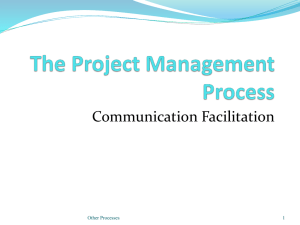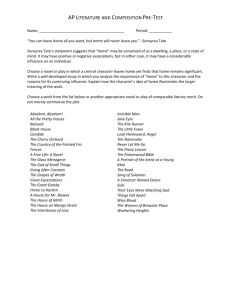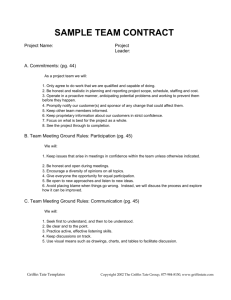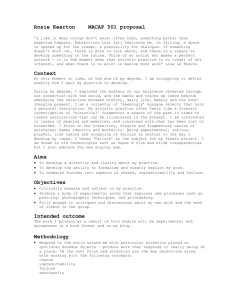C S : T
advertisement
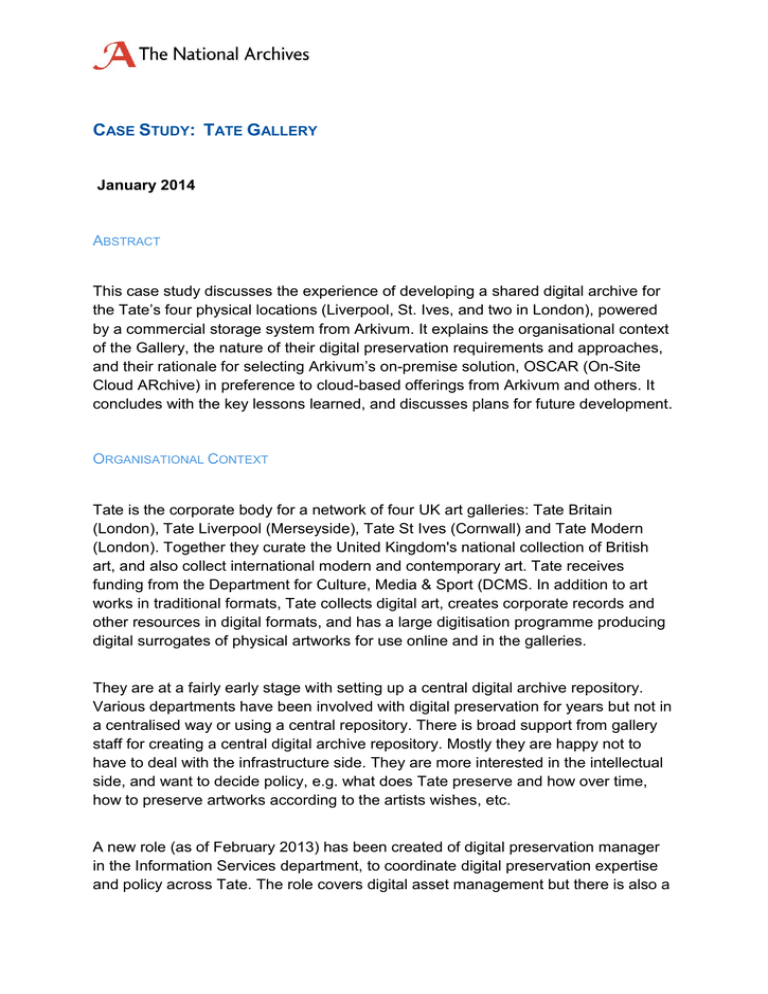
CASE STUDY: TATE GALLERY January 2014 ABSTRACT This case study discusses the experience of developing a shared digital archive for the Tate’s four physical locations (Liverpool, St. Ives, and two in London), powered by a commercial storage system from Arkivum. It explains the organisational context of the Gallery, the nature of their digital preservation requirements and approaches, and their rationale for selecting Arkivum’s on-premise solution, OSCAR (On-Site Cloud ARchive) in preference to cloud-based offerings from Arkivum and others. It concludes with the key lessons learned, and discusses plans for future development. ORGANISATIONAL CONTEXT Tate is the corporate body for a network of four UK art galleries: Tate Britain (London), Tate Liverpool (Merseyside), Tate St Ives (Cornwall) and Tate Modern (London). Together they curate the United Kingdom's national collection of British art, and also collect international modern and contemporary art. Tate receives funding from the Department for Culture, Media & Sport (DCMS. In addition to art works in traditional formats, Tate collects digital art, creates corporate records and other resources in digital formats, and has a large digitisation programme producing digital surrogates of physical artworks for use online and in the galleries. They are at a fairly early stage with setting up a central digital archive repository. Various departments have been involved with digital preservation for years but not in a centralised way or using a central repository. There is broad support from gallery staff for creating a central digital archive repository. Mostly they are happy not to have to deal with the infrastructure side. They are more interested in the intellectual side, and want to decide policy, e.g. what does Tate preserve and how over time, how to preserve artworks according to the artists wishes, etc. A new role (as of February 2013) has been created of digital preservation manager in the Information Services department, to coordinate digital preservation expertise and policy across Tate. The role covers digital asset management but there is also a gallery records manager responsible for Tate’s public records. Public records are generally interpreted as Tate corporate records, but in theory they could include everything that is created by Tate. There is a procurement manager and legal team, who they worked with closely on procurement of the technical infrastructure and services for the central digital repository as they needed to comply with government procurement rules. DIGITAL PRESERVATION Significance Digital preservation is of major significance to Tate. Tate has a Digital Preservation and Continuity Policy in place, but does not yet have processes and systems in place for the preservation of all types of digital assets. The need is certainly accepted across the organisation (esp. for born digital artworks). A lot more digital content is expected in future so the significance of digital preservation can only increase. Volumes have been increasing significantly over the last year – Tate is acquiring more digital art work and also creating more digital content itself e.g. audio visual material. They also expect a greater variety of born digital content. The novel formats in which some digital artworks may be created poses additional challenges which will need to be addressed. Current Approaches They have a top-down policy in place and are now coordinating implementation across the organisation. The time-based media conservation and photography sections already had policies in place. There are not a lot of detailed processes as yet but these are starting to develop now that they have a shared storage system and are beginning to roll it out more widely. Tate cannot really impose constraints on what formats they will accept. It is difficult to impose rules on an artist, but they are taking on artist’s personal archives and can advise artists on suitable formats. Cost is already a consideration in the acquisition of physical artworks so it is not that dissimilar to think through the future preservation costs for digital works. 2 How they would want this to change over the next three years Ultimately, Tate’s central repository should be available for all high value digital assets, but these all have different needs and there is a lot of work still to do in developing procedures for each type of asset. The team are also evaluating Archivematica for use in metadata workflow management. Range of content types and volumes of digital material Born-digital artworks are recognised as being the most critical, but digitisation and the number of surrogates produced is also increasing rapidly. Across Tate, the volume of digital media being produced is growing sharply. During procurement of the Arkivum system it was estimated that there were already 300 terabytes of high value content in need of a solution. Volume estimates keep changing, but over the next three years it is currently estimated that Tate will need two petabytes (2,048 terabytes) of storage capacity. This growth is partly a consequence of a digital transformation plan, which will see more processes at Tate become digital. ARKIVUM’S OSCAR STORAGE FOR DIGITAL PRESERVATION The initial impetus for a centralised digital storage solution was a Heritage Lottery Fund (HLF) grant for Tate Archives to digitise over 50,000 of the items in their collections. As part of the proposal, Tate had to state how they would meet and maintain standards for long-term preservation. They used some of the HLF funding to set up the infrastructure for an initial 10 terabytes of storage, scalable in case of an expected future expansion. The procurement process was relatively straightforward – they documented their initial storage needs and the requirement for expansion, and issued an ITT via a government procurement forum. There were around 11 submissions, and four were shortlisted. Arkivum stood out at the time because of their clear experience with both digital preservation and data storage. Their staff had previously worked on audiovisual preservation products so understood the issues, and their proposal fitted the Tate’s needs well. Tate weren’t looking for a cloud-based system as there was nervousness within the organisation about the security of this approach. The Arkivum OSCAR (On-Site Cloud ARchive) system allowed software to be installed on hardware inside the organisation’s firewall. It gave them a lot of control over the location of the system and their data and a good working relationship has been established with Arkivum. 3 Tate’s installation of OSCAR comprises a disk and tape-based system physically installed at two London sites. Arkivum are responsible for ongoing maintenance of the software and the hardware manufacturers directly support their equipment. The current hardware can address 77 terabytes of data through the simple insertion of additional tapes. Expansion units and reconfiguration could take the system to a total addressable storage of around one petabyte. There is network access to OSCAR’s storage from all Tate sites across the UK. Tate is working to improve inter-site network performance. There is a possibility of connecting to the Janet network which would significantly improve connections. During the initial HLF-funded digitisation project content will pass through Tate’s existing Digital Asset Management System (iBase Manager), which will manage any access to the archive masters. Access copies are stored separately and can also be accessed through iBase Manager or published on Tate’s website. The individual departments all want to use the storage, so they are having to prioritise what the storage is used for. The Digital Asset Management steering committee will be key to balancing expectations. A digital asset register, when complete, will list all the categories of digital asset with their value and risk associated. Tate will need to consider the funding model for the storage as it expands, and will look at including the cost of storage and ongoing preservation costs in acquisition proposals, as is already the case for physical collection items. New projects that include the creation of new digital assets will also need to consider storage and preservation requirements. TECHNICAL INFRASTRUCTURE Main software systems used for electronic content management, preservation and access services Tate relies upon several systems for access to digital data. These include Gallery Systems’ TMS as the content management system for artworks, Axiell’s Calm as an archive cataloguing database, and SirsiDynix’ Symphony in the Tate library. Arkivum’s OSCAR (On-Site Cloud ARchive) software is the latest addition, and is used to power the central digital repository for archival data. 4 BUSINESS CASE AND FUNDING A digital preservation system was mandated by the Heritage Lottery Fund as part of their grant to Tate so this was a major factor. Tate did cover the broader internal requirement as well in its internal business case prior to submitting a proposal to Heritage Lottery Fund. They highlighted the risks of potential loss of digital artworks and implications in terms of reputational damage. They also needed the buy in and the support of the Information Services department for ongoing maintenance and future expansion costs. Approximately £70,000 was required for the initial storage required for the setup of the Heritage Lottery Fund digitisation project (obviously more will be needed later for other ongoing and future needs). KEY LESSONS THEY HAVE LEARNT The business case is really important – you need buy in from all the stakeholders; Having a really good working relationship with the supplier is critical. Ensure that they have staff you can work with and that they understand your environment and needs; Take a step by step approach as otherwise it can be quite daunting. Start by creating an asset register documenting what you have in terms of volumes and categories, and move on to providing an archival storage solution. Then start addressing the other long term preservation issues; The end-to end process of working out requirements and procurement always takes longer than anticipated. Defining requirements took a long time to get started but once underway took about two months. The procurement took a further three months. FUTURE PLANS Expansion will need to be quite rapid and they also need to look at workflow for the different types of assets and add in the required processes for these. The individual departments all want to use the storage, so they are having to prioritise what the storage is used for. The Digital Asset Management steering 5 committee will be key to balancing expectations. A digital asset register, when complete, will list all the categories of digital asset with their value and risk associated. Tate will need to consider the funding model for the storage as it expands, and will look at including the cost of storage and ongoing preservation costs in acquisition proposals, as is already the case for physical collection items. New projects that include the creation of new digital assets will also need to consider storage and preservation requirements. Tate continues to monitor developments and best practice in relation to public cloud storage. Although there is no explicit policy restricting use of public cloud infrastructure, the gallery is hesitant about entrusting control of digital artworks to an external provider, and has specific audit requirements that will need to be considered. It is more relaxed about the management of its own internal records and documents, and is following the lead of relevant Government departments in exploring the use of cloud-based document and records management systems. FURTHER INFORMATION Tate: http://www.tate.org.uk/ Arkivum: http://www.arkivum.com/ Arkivum OSCAR (On-Site Cloud ARchive): http://www.arkivum.com/pages/resources/brochures/OscarBrochure Archivematica: http://www.archivematica.org/ Calm: http://www.axiell.co.uk/calm iBase: https://www.ibase.com/ Symphony: http://www.sirsidynix.com/symphony The Museum System (TMS): http://www.gallerysystems.com/tms 6
